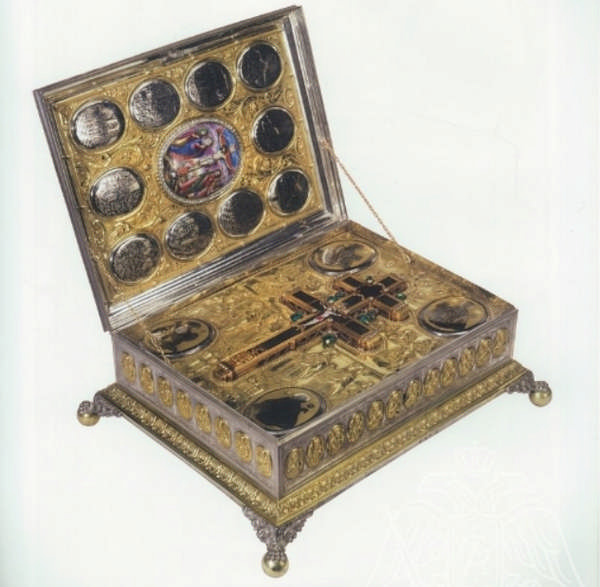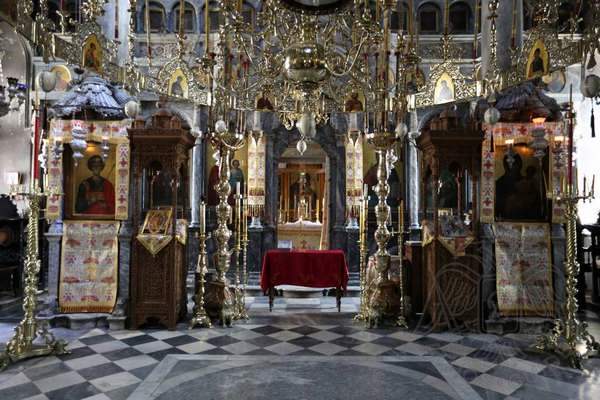Silverwork

In the katholikos of the holy monasteries of Mount Athos there are many sacred metalworking objects. Made of gold, silver or metal alloys, decorated with precious and semi-precious stones, these objects constitute an important cultural heritage of the monastic state. Some were produced in local workshops, while most of them were created in the large urban centers of Constantinople, Thessaloniki and Ioannina.
In most cases they are sacred objects, such as the Holy Grail, that are usually decorated with small representations, geometric shapes and floral designs.
As for the holy relics, they are kept in special silver reliquaries. Their shape varies. Some are rectangular, some are cross-shaped, while others are shaped according to their content. Among them, it is of great beauty the reliquary in which the Cincture of Theotokos is kept. It was given to the Vatopaidi Monastery by the Serbian ruler Lazar I. It is a golden construction, decorated with precious stones and enamel icons.
The relics of Saint Nephon, Patriarch of Constantinople, are also placed in a reliquary. It is shaped like a temple, with five domes. The inscription on it dated it back to the 1515.
The reliquaries in which the wooden parts of the True Cross are kept are also splendid examples of miniature craftsmanship. The vessel belonging to the Holy Monastery of Great Lavra is made of pure gold and is adorned with precious stones, emeralds, rubies, pearls, etc.
The True Cross was offered to Saint Athanasios the Athonite by the Emperor Nikiphoros Phokas. The case in which the Holy Wood is placed is glittering with gems, decorated with elaborate designs and inscriptions.
The True Cross of the Holy Monastery of Xeropotamou is the largest piece in the world. The part given to the Holy Monastery of Hilandar is decorated with all kinds of precious stones, bears the image of Jesus the Savior, the Virgin Mary and the saints. In the same reliquary, there are also kept parts of the crown of thorns, the shroud of Christ and the gifts of the Magi.
Copper Engraving

Objects with bronze relief decorations can be found in all the monasteries of Mount Athos. Of particular interest are the gates at the entrances of the katholikos. One of the most important works of art is the royal gate of the katholikon of the Holy Monastery of Great Lavra, which is covered with copper leaves. According to the athonite tradition, it was a gift from the Emperor Nikiphoros Phokas, which dates back to the 10th-11th century and which arrived in Mount Athos from Crete. The gate of the katholikon of the Vatopedi Monastery is also covered with rectangular copper sheets decorated with relief floral motifs, designs and representations, including a representation of the Annunciation of the Virgin Mary. This great masterpiece dates back to the 15th century.
The iron cross that Saint Athanasios wore during the long hours of the services and which weighs four kilograms, is also of great archaeological and religious value. Among other things, there is kept his metal rod by which he struck the ground and created the spring of Saint Athanasios. Today these objects are placed in the Holy Monastery of Great Lavra. Among the historical relics we can also find the bronze shield of Saint Mercurius, which is in the Holy Monastery of Pantokrator.
Some of the most impressive objects of Mount Athos are the oil lamps, which arrived in Athos mainly from abroad. The lamp in the katholikon of the Holy Monastery of Saint Paul, which has a diameter of five meters and is decorated with two-headed eagles, is one such example. It was created in Germany and dates back to 1669.
From the 9th century, when Italian bell towers arrived in the byzantine empire, they were immediately adopted and took a special place in the worship life of the Christian community. Today, all monasteries have their own bell tower. The Ottomans, who considered bells to be one of the strongest symbols of the presence of Christianity, banned their use all throughout the Ottoman Empire, except from Mount Athos.
Today the bells of the monasteries are mainly manufactured in Russia. The largest bell in the balkan peninsula is located in the Holy Monastery of Saint Panteleimon and weighs 13 tons.
As for the art of copper engraving, it became widespread in Mount Athos in the late 18th century.

